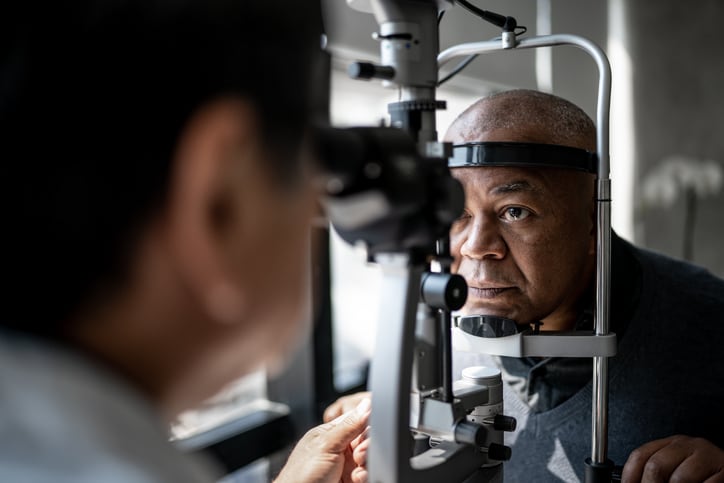
[5 MIN READ]
In this article:
-
Though there is no cure for glaucoma, early detection increases the chance of treating it.
-
To screen for glaucoma, it’s particularly important to undergo regular eye exams with dilation.
-
All of the tests used to check for glaucoma are painless.
Glaucoma prevention: Protect your vision
Aging can cause many changes to your eyes — some more noticeable than others. You may have to wear reading glasses to see up close, your eyes might feel drier or more sensitive to light, or you might be diagnosed with a new eye condition. One of the most common eye conditions that comes with age is glaucoma. January is National Glaucoma Awareness Month, and Providence providers want you to know what it is and how you can protect your vision.
Prevent glaucoma through regular eye exams
Glaucoma is one of the most common eye conditions people develop as they age. More than 3 million people in the U.S. have some type of glaucoma, which happens when extra eye pressure causes optic nerve damage. If you don’t treat glaucoma, it can cause permanent blindness.
The best way to prevent glaucoma is by having regular eye exams. The American Optometric Organization recommends that adults get regular eye exams every year, regardless of their eye health. In particular, it’s important to get your eyes dilated during your exam, because it allows the eye doctor to examine your optic nerve for signs of damage.
“Regular eye exams can find higher eye pressures and optic nerves that look suspicious for glaucoma,” says Meng Lu, M.D., ophthalmologist and glaucoma and cataract specialist with Providence’s Pacific Medical Centers Specialty Care. “Then, your optometrist can send you to a specialist for further testing.”
Additionally, the American Academy of Ophthalmology recommends that you get an eye disease baseline screening by an ophthalmologist at age 40. This screening is more comprehensive than what you receive at your optometrist’s office. However, if you have risk factors for eye disease, such as diabetes, high blood pressure or a family history of eye disease, you should have the screening much sooner.
Who is at risk of glaucoma?
While glaucoma is one of the leading causes of blindness in older people, it can occur in people of any age. It may be present in a newborn baby or develop in a child’s first few years of life. Certain types of glaucoma can also affect people ages 20 to 50 years old.
Diabetes, in particular, is a major risk factor for glaucoma. Adults with diabetes are twice as likely to get glaucoma as those who don’t have diabetes. This is because diabetes can damage blood vessels throughout the eye, impacting the supply of oxygen and nutrition to the optic nerve. When the optic nerve doesn’t have the proper amount of oxygen and nutrition, it is more likely to suffer damage from high pressure.
Regular eye exams are especially important for older adults, who are six times more likely to develop glaucoma after age 60.
Lifestyle adjustments to lower glaucoma risk
In addition to seeing your eye doctor regularly, you also can make the following lifestyle adjustments for the general health of your eyes:
- Eat plenty of leafy green vegetables and colored fruits every day.
- Participate in moderate (not intense) exercise to get more blood flow to the optic nerve.
- Wear protective eyewear when participating in sports and working around your house.
- Don’t place your head in a downward position for a long period of time.
- Avoid sleeping with your eye(s) against the pillow or on your arm.
- Protect your eyes from sunlight with UV protection glasses or sunglasses.
Debunking common glaucoma myths
Some of the most common myths include:
Myth 1: Surgery can cure glaucoma.
Fact: While some surgical procedures can keep glaucoma from becoming worse and help lower the pressure in your eye, there is no surgery that can completely cure it.
Some of the surgeries that doctors use to treat glaucoma include:
- Trabeculectomy — During this procedure, the surgeon creates a tiny trap door on the white part of the eye under the eyelid, allowing fluid to drain out of the eye, lowering the eye pressure.
- Glaucoma implant surgery — During this procedure, the surgeon implants a tiny tube into the eye to help drain fluid out of it.
- Minimally invasive glaucoma surgery (MIGS) — These are minimally invasive surgeries that may be done individually or in combination with cataract surgery to reduce eye pressure. They often have faster healing times than the above surgeries.
Myth 2: The tests used to detect glaucoma are painful.
Fact: All of the tests that doctors use to detect glaucoma are painless. The two most common tests are tonometry and ophthalmoscopy, but a visual field test can also be done:
- Tonometry — During this test, the doctor or technician uses eye drops to numb the eye, then presses a small device called a tonometer against the cornea to measure the eye’s inner pressure.
- Ophthalmoscopy — During this exam, the doctor uses a light to examine the optic nerve for signs of glaucoma damage.
- Visual field test — This test looks for peripheral vision loss, which can often be seen initially in glaucoma. The patient looks at a dot in the center of a screen and pushes a button every time a light flashes.
Myth 3: Cataracts can progress into glaucoma.
Fact: Cataracts and glaucoma are two completely different conditions. While glaucoma is related to the pressure of the eye, a cataract is a clouding of the eye’s lens. However, both glaucoma and cataracts share common risk factors, such as increasing age, diabetes and a previous eye injury. Because of this, many people who have cataracts also have glaucoma.
Myth 4: You will notice the symptoms of glaucoma right away.
Fact: Open-angle glaucoma, which is the most common form of glaucoma, can sneak up on a person. You can have completely normal vision and still suffer from glaucoma. That’s why it’s so important to get your eyes examined regularly.
What to expect from glaucoma treatment
There is no cure for glaucoma, but there are several ways to treat it. “Glaucoma is treated by lowering eye pressures,” says Dr. Lu. “This is done with drops, laser treatment or surgery. However, because it can’t be cured, you will still need continued follow-up and treatment.”
The most important part of treatment is starting in the early stages of the disease process — and the best way to do that is through regular eye exams.
Contributing caregivers

Meng Lu, M.D., is an ophthalmologist and glaucoma and cataract specialist with Providence’s Pacific Medical Centers Specialty Care.
Find a doctor
If you are looking for a Providence optometrist or ophthalmologist, search for one in our provider directory.
Download the Providence app
It’s all in the app: easily stay connected with Providence and your health. With the Providence app, you can schedule appointments, have virtual visits from the comfort of your own home, get health recommendations personalized for you, access your health records and so much more. Learn more and download the app.
Related resources
Why you should take a closer look at your eyes as you age
4 optical problems diabetics should keep an eye on
This information is not intended as a substitute for professional medical care. Always follow your health care professional’s instructions.
About the Author
More Content by Providence Health Team








